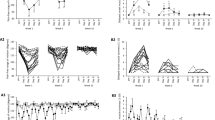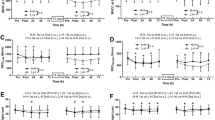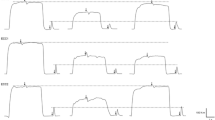Abstract
The aim of this study was to compare the possible changes in muscle activation level between a first and second bout of damaging eccentric exercise performed at 2 weeks interval (i.e. repeated bout effect). To that purpose, ten physically active males took part in this study. The eccentric exercise consisted of 10 sets of 12 maximal voluntary contractions (MVC) produced by the knee extensors during movements performed at a constant speed of 160°s−1. Changes in voluntary and electrically evoked torque in concentric and/or isometric conditions were assessed at the following time points: pre-exercise, and 2 min, 1 and 24 h after each eccentric exercise. At the same time points, voluntary activation was quantified by the superimposed electrical stimulation technique. Muscle soreness and plasma CK activity were measured within 48 h after the eccentric exercise. The results showed that the decrease in eccentric peak torque was linear throughout the exercise protocol. At the end of bouts 1 and 2, torque was significantly reduced by 27.7 ± 9.1 and 23.4 ± 11.2, respectively, with no difference between bouts (P > 0.05). At 24 h post-exercise, a lower reduction (P < 0.05) in MVC (17.8 ± 5.4%) and electrically evoked (16.7 ± 4.6%) isometric torque was observed for bout 2. In contrast, no statistical difference was found in the deficit in voluntary activation between the two bouts. In conclusion, our results indicate that the repeated bout effect of eccentric exercise appears to reduce muscle damage, but does not influence the level of voluntary activation.



Similar content being viewed by others

References
Amann M, Dempsey JA (2008) Locomotor muscle fatigue modifies central motor drive in healthy humans and imposes a limitation to exercise performance. J Physiol 586(1):161–173
Arms SW, Pope MH, Johnson RJ, Fischer RA, Arvidsson I, Eriksson E (1984) The biomechanics of anterior cruciate ligament rehabilitation and reconstruction. Am J Sports Med 12(1):8–18
Behm D, Power K, Drinkwater E (2001) Comparison of interpolation and central activation ratios as measures of muscle inactivation. Mus Nerv 24(7):925–934
Bigland-Ritchie B, Furbush F, Woods JJ (1986) Fatigue of intermittent submaximal voluntary contractions: central and peripheral factors. J Appl Physiol 61(2):421–429
Bilodeau M (2006) Central fatigue in continuous and intermittent contractions of triceps brachii. Mus Nerv 34:205–213
Butterfield TA, Herzog W (2006) The magnitude of muscle strain does not influence serial sarcomere number adaptations following eccentric exercise. Pflugers Arch 451:688–700
Byrne C, Twist C, Eston R (2004) Neuromsucular function after exercise-induced muscle damage: theoretical and applied implications. J Sports Med 1:49–69
Chen TC, Nosaka K (2006) Responses of elbow flexors to two strenuous eccentric exercise bouts separated by three days. J Strength Cond Res 20(1):108–116
Chen TC, Nosaka K, Sacco P (2007) Intensity of eccentric exercise, shift of optimum angle, and the magnitude of repeated-bout effect. J Appl Physiol 102(3):992–999
Day SH, Donnelly AE, Brown SJ, Child RB (1998) Electromyogram activity and mean power frequency in exercise-damaged human muscle. Mus Nerv 21(7):961–963
de Haan A, Gerrits KH, de Ruiter CJ (2009) Counterpoint: the interpolated twitch does not provide a valid measure of the voluntary activation of muscle. J Appl Physiol 107(1):355–357
de Ruiter CJ, Hoddenbach JG, Huurnink A, de Haan A (2008) Relative torque contribution of vastus medialis muscle at different knee angles. Acta Physiol 194(3):223–237
Duchateau J, Balestra C, Carpentier A, Hainaut K (2002) Reflex regulation during sustained and intermittent submaximal contractions in humans. J Physiol 541:959–967
Enoka RM, Duchateau J (2008) Muscle fatigue: what, why and how it influences muscle function. J Physiol 586(1):11–23
Fridén J, Kjörell U, Thornell LE (1984) Delayed muscle soreness and cytoskeletal alterations: an immunocytological study in man. Int J Sports Med 5(1):15–18
Gandevia SC (2001) Spinal and supraspinal factors in human muscle fatigue. Physiol Rev 81:1725–1789
Gandevia SC, Allen GM, Butler JE, Taylor JL (1996) Supraspinal factors in human muscle fatigue: evidence for suboptimal output from the motor cortex. J Physiol 490:529–536
Gregory JE, Morgan DL, Allen TJ, Proske U (2007) The shift in muscle’s length–tension relation after exercise attributed to increased series compliance. Eur J Appl Physiol 99:431–441
Herbert RD, Gandevia SC (1999) Twitch interpolation in human muscles: mechanisms and implications for measurement of voluntary activation. J Neurophysiol 82(5):2271–2283
Hirokawa S, Solomonow M, Lu Y, Lou ZP, D’Ambrosia R (1991) Muscular contraction and control of knee stability. J Electromyogr Kinesiol 1:199–208
Hortobágyi T, Hill JP, Houmard JA, Fraser DD, Lambert NJ, Israel RG (1996) Adaptive responses to muscle lengthening and shortening in humans. J Appl Physiol 80(3):765–772
Keenan KG, Farina D, Maluf KS, Merletti R, Enoka RM (2005) Influence of amplitude cancellation on the simulated surface electromyogram. J Appl Physiol 98(1):120–131
Kent-Braun JA, Le Blanc R (1996) Quantitation of central activation failure during maximal voluntary contractions in humans. Mus Nerv 19(7):861–869
Koh TJ, Brooks SV (2001) Lengthening contractions are not required to induce protection from contraction-induced muscle injury. Am J Physiol Regul Integr Comp Physiol 281(1):R155–R161
Kuitunen S, Avela J, Kyröläinen H, Komi PV (2004) Voluntary activation and mechanical performance of human triceps surae muscle after exhaustive stretch–shortening cycle jumping exercise. Eur J Appl Physiol 91(5/6):538–544
Lapier TH, Burton HW, Almon R, Cerny F (1995) Alterations in intramuscular connective tissue after limb casting affect contraction-induced muscle injury. J Appl Physiol 78(3):1065–1069
Lehti TM, Kalliokoski R, Komulainen J (2007) Repeated bout effect on the cytoskeletal proteins titin, desmin, and dystrophin in rat skeletal muscle. J Muscle Res Cell Motil 28(1):39–47
Levick JR (1983) Joint pressure–volume studies: their importance, design and interpretation. J Rheumatol 10(3):353–357
Löscher WN, Cresswell AG, Thorstensson A (1996) Recurrent inhibition of soleus, alpha-motoneurons during a sustained submaximal plantar flexion. Electroencephalogr Clin Neurophysiol 101(4):334–338
MacIntyre DL, Sorichter S, Mair J, Berg A, McKenzie DC (2001) Markers of inflammation and myofibrillar proteins following eccentric exercise in humans. Eur J Appl Physiol 84:180–186
McHugh MP (2003) Recent advances in the understanding of the repeated bout effect: the protective effect against muscle damage from a single bout of eccentric exercise. Scand J Med Sci Sports 13:88–97
Millet GY, Martin V, Lattier G, Ballay Y (2003) Mechanisms contributing to knee extensor strength loss after prolonged running exercise. J Appl Physiol 94(1):193–198
Morgan DL (1990) New insights into the behaviour of muscle during active lengthening. Biophys J 57(2):209–221
Morgan DL, Allen DG (1999) Early events in stretch-induced muscle damage. J Appl Physiol 87:2007–2015
Nosaka K, Clarkson PM (1995) Muscle damage following repeated bouts of high force eccentric exercise. Med Sci Sports Exerc 27:1263–1269
Pasquet B, Carpentier A, Duchateau J (2005) Change in muscle fascicle length influences the recruitment and discharge rate of motor units during isometric contractions. J Neurophysiol 94:3126–3133
Philippou A, Bogdanis GC, Nevill AM, Maridaki M (2004) Changes in the angle–force curve of human elbow flexors following eccentric and isometric exercise. Eur J Appl Physiol 93(1/2):237–244
Pincivero DM, Salfetnikov Y, Campy RM, Coelho AJ (2004) Angle- and gender-specific quadriceps femoris muscle recruitment and knee extensor torque. J Biomech 37:1689–1697
Pizza FX, Koh TJ, McGregor SJ, Brooks SV (2002) Muscle inflammatory cells after passive stretches, isometric contractions, and lengthening contractions. J Appl Physiol 92(5):1873–1878
Prasartwuth O, Taylor JL, Gandevia SC (2005) Maximal force, voluntary activation and muscle soreness after eccentric damage to human elbow flexor muscles. J Physiol 567:337–348
Prasartwuth O, Allen TJ, Butler JE, Gandevia SC (2006) Length-dependent changes in voluntary activation, maximum voluntary torque and twitch responses after eccentric damage in humans. J Physiol 571:243–252
Sahlin K, Ren JM (1989) Relationship of contraction capacity to metabolic changes during recovery from a fatiguing contraction. J Appl Physiol 67(2):648–654
Saxton JM, Donnelly AE (1996) Length-specific impairment of skeletal muscle contractile function after eccentric muscle actions in man. Clin Sci (Lond) 90(2):119–125
Serrão FV, Foerster B, Spada S, Morales MM, Monteiro-Pedro V, Tannús A, Salvini TF (2003) Functional changes of human quadriceps muscle injured by eccentric exercise. Braz J Med Biol Res 36(6):781–786
Skurvydas A, Streckis V, Mickeviciene D, Kamandulis S, Stanislovaitis A, Mamkus G (2006) Effect of age on metabolic fatigue and on indirect symptoms of skeletal muscle damage after stretch–shortening exercise. J Sports Med Phys Fitness 46:431–441
Streckis V, Skurvydas A, Ratkevicius A (2007) Children are more susceptible to central fatigue than adults. Mus Nerv 36:357–363
Strojnik V, Komi PV (1998) Neuromuscular fatigue after maximal stretch–shortening cycle exercise. J Appl Physiol 84:344–350
Sutter E, Herzog W (1997) Extent of muscle inhibition as a function of knee angle. J Electromyogr Kinesiol 7:123–130
Taylor JL (2009) Point: the interpolated twitch does/does not provide a valid measure of the voluntary activation of muscle. J Appl Physiol 107(1):354–355
Warren GL, Lowe DA, Armstrong RB (1999) Measurement tools used in the study of eccentric contraction-induced injury. Sports Med 27(1):43–59
Warren GL, Hermann KM, Ingalls CP, Masselli MR, Armstrong RB (2000) Decreased EMG median frequency during a second bout of eccentric contractions. Med Sci Sports Exerc 32(4):820–829
Warren GL, Ingalls CP, Lowe DA, Armstrong RB (2001) Excitation–contraction uncoupling: major role in contraction-induced muscle injury. Exerc Sport Sci Rev 29(2):82–87
Yeung SS, Yeung EW (2008) Shift of peak torque angle after eccentric exercise. Int J Sports Med 29:251–256
Yu JG, Carlsson L, Thornell LE (2004) Evidence for myofibril remodelling as opposed to myofibril damage in human muscles with DOMS: an ultrastructural and immunoelectron microscopic study. Histochem Cell Biol 121:219–227
Acknowledgments
We would like to thank Dr. Nerijus Masiulis and Dr. Kazys Vadopalas for their technical support. This study was supported by the Lithuanian State Science and Studies Foundation.
Conflict of interest statement
The authors declare that they have no conflict of interest.
Author information
Authors and Affiliations
Corresponding author
Additional information
Communicated by Arnold de Haan.
Rights and permissions
About this article
Cite this article
Kamandulis, S., Skurvydas, A., Brazaitis, M. et al. The repeated bout effect of eccentric exercise is not associated with changes in voluntary activation. Eur J Appl Physiol 108, 1065–1074 (2010). https://doi.org/10.1007/s00421-009-1219-y
Accepted:
Published:
Issue Date:
DOI: https://doi.org/10.1007/s00421-009-1219-y



